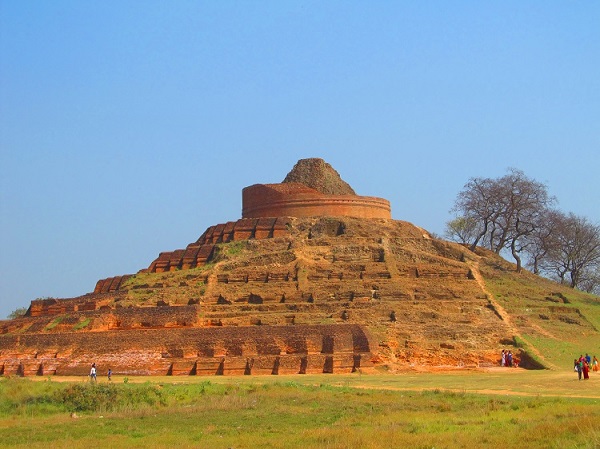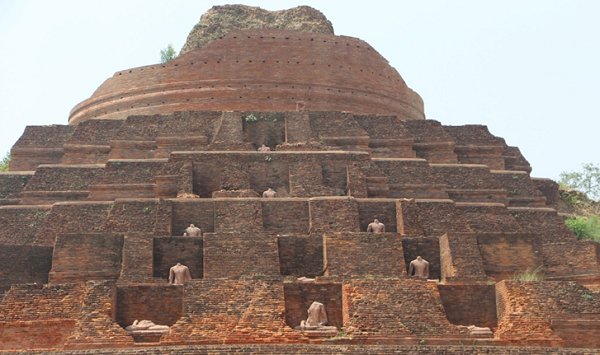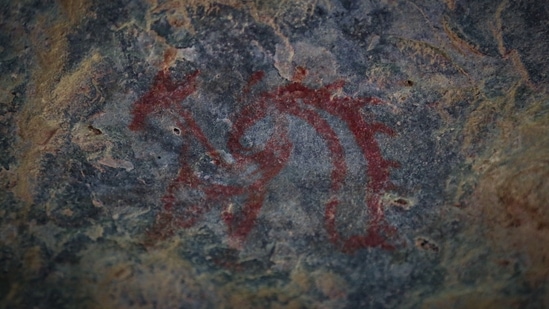If an average person in Patna were asked about the Kesariya stupa, chances are that the person would be entirely unaware of it or at best would have a vague idea of it being located in the state. Unless they were history buffs. By rights, the gigantic stupa in Bihar’s East Champaran has the potential to be the foremost Buddhist site in India. Instead, it stands in a semi-excavated area, visited largely by the historically inclined, waiting for its share of the glory. The few locals who turn up usually come on festive days to worship at a relatively new temple that has been allowed to come up in the grounds.

The stupa at Kesariya
A visitor to the site is startled by the visual similarity between the stupas at Kesariya and at Borobudur, in the Indonesian island of Java. Both stupas are massive at the base and rise vertically in a pyramid-shaped structure, with terraces at every level. And at various levels are rock carvings of Buddhas seated in meditative posture. In a remarkable coincidence, the ‘re-discovery’ and first exploration of both Kesariya and Borobudur’s stupas took place in the same year – 1814.

The stupa at Borobudur, on the island of Java in Indonesia
In the case of the Kesariya, after an initial exploration by Col. Mackenzie in 1814, the first proper exploration took place under the guidance of Alexander Cunningham in 1861-62. He dated the stupa to a period somewhere between the 2nd and 7th centuries CE but debate on the date has continued ever since with no conclusion. Excavating the Raniwas mound next to the stupa, Cunningham also unearthed the remains of a Buddhist monastery, including a large Buddha icon. His report suggests a link between the monastery and the stupa.

Buddha icons at Kesariya

Buddha icons at Borobudur, restored to original glory
What brought Cunningham to this site? Apart the presence of an ancient site that Mackenzie would have reported, there are many stories linked to the place. Associated with the Raniwas mound and the stupa is the name of an ancient ‘chakravartin’ king called Bena, who is attributed with superhuman powers. As the story goes, misconduct on the part of Bena caused the powers to leave him and to the death of his wife, who drowned in a tank. In anguish, the king built the stupa and entered it with the rest of his family, never to be seen again.
Beyond the legend, an account left behind by Chinese traveller Hiuen Tsang, who passed through the region, mentions the presence of a stupa in the Champaran region, north west of the Buddhist site at Vaishali. This seems a clear pointer to Kesariya. Importantly, Hiuen Tsang’s story reveals that the Buddhist community calls the structure a ‘chakravartin stupa’, in a possible reference to the King Bena story.
Kesariya is also spoken of as a site of high significance in the life of the Buddha. The legend holds that the Buddha spent at night at Kesariya while gong from Vaishali to Kushinagar. It is here that he told his Licchavi disciples of his impending nirvana and told them to return to Vaishali, giving them his alms-bowl as a token of remembrance. The Licchavis built a stupa at this spot to commemorate the event.
Independent India saw its first excavation at the site as late as 1998, under the leadership of KK Muhammad, one of the finest archaeologists to grace the ASI. Amongst his findings were bricks of the Late Gupta period and even from later periods indicating that the stupa was added to, over time. Whatever its past, the stupa today is a lofty brick mound topped by a stone tower. This is where the comparison with Borobudur comes to an end. In front of the main stupa is the site of a large ongoing excavation. Sadly, the back of the stupa remains covered in mud with trees growing on it. (Below – the partially covered stupa slopes, with trees growing; and the semi excavated site – pictures from March 2019)



In the 1950s, parts of Borobudur were in danger of collapsing. With funding from five donor countries, a massive restoration project was undertaken which involved dismantling parts of the structure including the five platforms which made up the pyramid. In effect, the site was reconstructed. Both Kesariya and Borobudur suffered earthquake damage in their past. While Borobudur’s reconstruction has ensured it stands 112 ft high, Kesariya is not far away at 104 ft, with no reconstruction or even an attempt at restoration. Borobudur achieved UNESCO World Heritage status in 1991 and its presence has put Java’s heritage on the world map. Can we dream of such a future for the Kesariya?
Borobudur vs Kesariya: An outline
| Development | Borobudur | Kesariya |
| Date of first site | 9th century CE | 3rd century BCE |
| Current structure | – | 4th century CE |
| Abandoned | 15th century (approx.) | 12th century (approx.) |
| Associated with bad luck, misery | Late 18th century | – |
| First exploration | 1814 | 1814 |
| Initial work | First photographed: 1872 | Initial excavation: 1861-62 |
| Initial restoration | 1907-11 | – |
| By the 1950s | Ruined by earthquake damage, volcanic ash | In a ruined state, very little excavation |
| Last major excavation & restoration | 1975-82, with funding from 5 countries | 1998 (partial excavation only) |
| UNESCO World Heritage status | 1991 | – (even people in Bihar unaware) |
| Annual visitors (pre-Covid) | 5 million | Unknown |
| Entry fee (for foreigners) | 25$ | Entry free |






